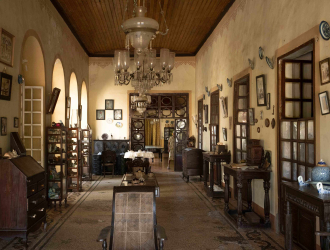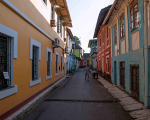Of all European powers that colonised India, Portugal ruled the longest. They first arrived in India in 1498 CE, when Vasco da Gama reached Calicut by rounding the Cape of Good Hope. In 1510, Afonso de Albuquerque captured Goa from the Sultanate of Bijapur, thus establishing the territories of Estado Português da Índia (Portuguese State of India). This marked the beginning of 450 years of uninterrupted rule from Lisbon, which ended when India militarily annexed Goa in December 1961. Goa was granted statehood on May 30, 1987.
Goa served as the main base for Portuguese expeditions to the Gulf of Hormuz, Malacca Strait, Africa and the Far East. During this period, Goa was shaped by ideas introduced from mainland Europe, but remained insulated from the rest of India. Even 300 years of British rule didn’t impact Goa. Instead, Goa developed a unique blend of Konkani customs indigenous to the region and Catholic traditions spread by Christian missionaries. An additional factor was imports from the Portuguese Empire scattered in various parts of the world. Over time, these diverse influences blended seamlessly to give rise to a culture that is uniquely ‘Goan’.
Portugal enriched Goa in many ways, most visible in architecture. The old capital, Velha Goa, is now a UNESCO World Heritage site, famous for its churches, chapels and convents. They are the only examples of Baroque style of architecture in India. Though many Portuguese descendant families have emigrated, some families still live in palatial country houses. These heritage mansions are perhaps the oldest continually inhabited private residences in India. One such heritage mansion I visited was Braganza House, located in Chandor village, now maintained by the Pereira-Braganza family. This seventeenth-century mansion evokes an old-world charm with its antique furniture, furnishings, paintings and objects d'art collected from all over Europe and sourced from Portuguese colonies in Africa, South America and Far East Asia.
At the new capital, Panjim (Panaji), the Fontainhas neighbourhood is lined with houses painted in mustard, indigo, salmon, olive, and similar bold and bright colours. White is used for churches and as trim around windows. Arched windows and projecting wrought-iron balconies exude a typically Mediterranean vibe, yet they have a sense of Indianness because they were built by Indian masons, using indigenous building techniques, keeping in mind the monsoon and long hot summer months, and availability of raw materials. For example,the walls and pillars were built of red laterite stone and local wood, while the sloping roofs were overlaid with terracotta tiles from Mangalore. In an era when glass was rare and very expensive, windows were covered with polished mother-of-pearl. Therefore, while we see Portuguese influence in design, the use of local materials for construction make them ‘Goan’.
The Hindu community, too, have left an indelible mark on architecture. Just as in Brahmin and Vaishnava households, some houses feature a central courtyard, with a tulsi manch (Holy Basil shrine) placed in the middle. In the month of Kartika (according to the Hindu calendar), many Goan households perform tulsi vivah (marriage), when the Tulsi plant is married to Lord Vishnu, either in his own image or as shaligram (black fossilised shell worshipped as a manifestation of Lord Vishnu). Though symbolic in nature, the vivah is performed as per traditional Hindu wedding rituals.
In Siolim village, Bardez Taluka, zagor is performed by both Christians and Hindus; it is the oldest Konkani folk theatre traditions in Goa with certain rituals to honour and worship a pantheon of ancestors, gods, saints, and spirits. Zagor is Konkani for jagarana, meaning ‘all-night vigil’. As the name suggests, during zagor, the entire village comes together and stays awake through the night, with performances of dance, song, music and theatre. Among native Konkanis, the Perni community used to perform zagor in temples, and it was their main source of income. Zagor was also performed by the Gaudas, the original inhabitants of Goa.
Goan culture is incomplete without mention of its spicy food. After all, it was in search of spices that Vasco da Gama first arrived in India! However, the Portuguese not only traded spices from India to Europe, but they also introduced new spices to India from their colonies in South America. It was through Goa that potato, tomato, maize, papaya, peanut, guava, avocado, capsicum, pumpkin, and, most importantly, chilli peppers were introduced in India. It is difficult to imagine Indian cuisine without these ingredients now!
Goa is famous for its home-grown spices, like kokum (Garcinia Indica), tamarind, mustard, asafoetida, nutmeg, chilli, pepper, cardamom and curry leaves. The Portuguese also introduced cashew. Goa is a major producer of cashew, and it is a key ingredient in Goan food and drink. While cashew seed (nut) is used in garnishing sweets and desserts, or sold as dry snacks, the cashew fruit is mashed and the juice extracted and fermented to produce a strong spirit, locally called feni. Feni is also made from toddy palm, though cashew feni is more popular, it is seasonal compared to coconut feni, which is available throughout the year. Coconut feni is indigenous, and another example of how an Indian practice was adapted to suit a fruit introduced by the Portuguese.
Like its spices, Goan cuisine is varied. There are two major strains—one influenced by Hindu Saraswat cuisine and one by Portuguese cuisine. The Hindu Saraswat cuisine does not include meat and is instead fish-centric. With its long coastline and rivers flowing down from the Western Ghats, Goa abounds in fish, both freshwater and marine. It is only natural that fish is a key ingredient of Goan cuisine. In contrast, Goan Catholics use a lot of meat, especially pork. The Portuguese introduced the fiery chorizo, a fermented, cured, smoked pork sausage, which may be sliced and eaten in a sandwich, grille, or cut into chunks and served with rice. Chorizos are sold in Mapusa market. The distinctive colour of the red sausages come from the use of red chilli. Goan chorizo is flavoured in a marinade (a mixture of vinegar, red chillies, and spices such as garlic, ginger, cumin, turmeric, cloves, pepper, and cinnamon) in which the meat is soaked, then stuffed into casings, tied with twine at intervals. If eaten as a sandwich, the chorizo is stuffed in chewy poi bread or eaten with the softer, crustier pao (Portuguese for bread) and the butterfly-shaped katro pao. Other bread varieties include the bagel-shaped kankon pao (named after a type of bangles, kankan, it resembles) and the round-shaped undo.
Goan culture is a product of centuries of intermixing of Europe and India, built upon a foundation of older Konkani society. Goans—despite their differences—manage to coexist as one community, speaking a shared mother tongue, Konkani. This melting pot of customs and traditions is reflected in the daily lives of the people in the villages where communities live in a mixed society, partaking in each other’s festivals, rituals, food, sports, theatre, dance and music. Unfortunately, the tourism industry hasn’t sensitised visitors from outside Goa about Goan culture, and the state has been negatively stereotyped in popular culture. Hopefully, the ‘beaches, booze and party’ image of Goa will change, and Indians will better understand and appreciate Goa’s unique, eclectic, and sometimes eccentric culture.
This photo-essay has been created as part of the Sahapedia Frames Photography Grant, supported by CSR funding from IndusInd Bank.
















